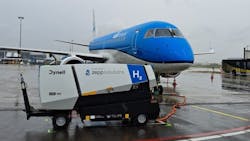KES and KLM conducted their first live test of Dynell’s DHM 090 model hydrogen GPU on an aircraft at Amsterdam Airport Schiphol in July.
Leading up to the GSE Expo Europe in Lisbon in September, Dynell sought to show the ground support market that a hydrogen-fueled GPU can be a viable alternative to diesel- and battery-powered units.
“The testing was to demonstrate, first, that this unit is working on a real aircraft,” explained Michael Brandstötter, head of sales and marketing at Dynell.
As part of a consortium project for the European Union’s TULIPS program, the test was performed in conjunction with partners like Schiphol Airport, fuel cell system provider Zepp Solutions, KES and KLM (KLM Cityhopper). The DHM 090, which provides 350kWh for 90kVA operation, was tested on an Embraer aircraft.
“We are very happy to be the first ones to use and try the H-GPU on an aircraft. I think it is a big milestone in the aviation sector as hydrogen powered equipment might have the potential to fill the gap that is left by battery powered equipment,” said Jasper Poortvliet, GSE fleet manager at KES. “The first test shows that we can successfully provide ground power to an aircraft without any significant impact on the airport operations.”
Brandstötter agreed that the first test went smoothly.
“It’s an integration of a fuel cell packed together with part of our existing battery GPU because you need a kind of battery for the peaks. The fuel cell with a capacity of 50kW is there to charge the battery and act like a range extender,” he said. “Everything below and above, what the hydrogen cell cannot do, is done by the battery itself.
“We will have some learnings about what can be improved, especially in regard to tank size, and also the right-sizing of the battery, itself,” Brandstötter continued. “But we have to gain data over the next months to see what can be improved.”
Dynell and its partners will continue testing for several months to gather data on the unit’s endurance. The unit will be sent to Torino Airport in Italy and Larnaca International Airport in Cyprus, before returning to Schiphol for more intensive testing.
In addition to endurance tests, Brandstötter said hot and cold climate testing will also be important.
“Cold temperatures could affect battery and fuel cell performance although there are heaters installed on both, while a hot climate can present thermal control challenges for both the battery and fuel cell systems. Tests in both climates will prove the effectiveness of the heating and cooling systems that have been developed for the hydrogen GPU,” he said.
While testing continues, Brandstötter highlighted potential advantages of utilizing hydrogen GPUs, particularly at remote stands. For example, a hydrogen GPU can be refueled by a mobile refueller in a matter of minutes without needing to be towed back to the terminal or hangar to connect the hydrogen GPU for charging.
Because the unit offers 350 kilowatt hours of usable energy which is more than double the stored energy compared to a battery GPU, Dynell officials estimate 7-9 turnarounds a day could be conducted for 2-3 days before refueling would be required. The hydrogen units are also scalable for larger aircraft.
“For a hydrogen GPU, to double the converter to generate two-times 90 kVA is not the biggest challenge” said Brandstötter. “Increasing the capacity, you can simply scale the hydrogen tanks a little bit bigger to have even more energy capacity or just simply place two 90 kVA hydrogen GPU there to be absolutely sure the capacity is enough with around 700 kWh.”
About the Author
Josh Smith
Editor
Josh Smith served as editor of Ground Support Worldwide as editor from 2016 through 2024. He oversaw production of the print magazine, created GSW's newsletters on a daily basis, and updated the latest news on AviationPros.com.

